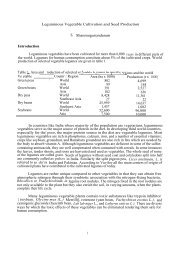Management of the Diamondback Moth and Other Crucifer Insect ...
Management of the Diamondback Moth and Other Crucifer Insect ...
Management of the Diamondback Moth and Other Crucifer Insect ...
You also want an ePaper? Increase the reach of your titles
YUMPU automatically turns print PDFs into web optimized ePapers that Google loves.
egulatory approval <strong>and</strong> authorization for commercialrelease. Concern focused particularly around <strong>the</strong> liabilityfor unauthorized release, both in India during <strong>the</strong> nationalagronomic trials process run by ICAR <strong>and</strong> <strong>the</strong>Agricultural Universities, <strong>and</strong> through <strong>the</strong> unauthorizedmovement <strong>of</strong> seeds into counties in which <strong>the</strong>y were notapproved <strong>and</strong> indeed which may have no approvalsprocess in place. In addition to seeking biosafety <strong>and</strong>growing approval in India, CIMBAA planned to seekimport approval in USA, Canada, Europe <strong>and</strong> Japan <strong>and</strong>cultivation approval in ‘second tier’ countries – such asBangladesh <strong>and</strong> <strong>the</strong> Philippines. Synchronizing <strong>the</strong>seapprovals with <strong>the</strong> registration process in India wasclearly going to be a very major challenge.Regulatory challenges <strong>and</strong> <strong>the</strong> Bteggplant experienceCIMBAA also had to consider <strong>the</strong> lack <strong>of</strong> progress with<strong>the</strong> Maharashtra Hybrid Seed Company (Mahyco)Cry1Ac Bt eggplants in India, which had also been donorsupported, in particular by USAID. These plants had metall <strong>the</strong> regulatory requirements for approval <strong>and</strong> release,including <strong>the</strong> nation-wide agronomic testing <strong>of</strong> <strong>the</strong>transformed material by mid 2009. The company hadmade breeding material available to AgriculturalUniversities <strong>and</strong> indeed to Bangladesh <strong>and</strong> <strong>the</strong>Philippines. In late 2009 <strong>the</strong> decision on whe<strong>the</strong>r torelease <strong>the</strong> Bt eggplants was passed to <strong>the</strong> Minister <strong>of</strong>Environment <strong>and</strong> Forests. He called for extensive publicconsultation over <strong>the</strong> following few months, ending in<strong>the</strong> decision in Feb 2010 to delay any release pendingundefined fur<strong>the</strong>r studies <strong>and</strong> setting up fur<strong>the</strong>r reviewcommittees. The nature <strong>of</strong> <strong>the</strong>se studies has not beendefined subsequently nor have <strong>the</strong> committees reported.For CIMBAA this made <strong>the</strong> regulatory environmenthighly uncertain, given <strong>the</strong> commercial rule <strong>of</strong> thumbthat ever year <strong>of</strong> delay in commercialisation <strong>of</strong> a newagricultural product knocks 10% <strong>of</strong> <strong>the</strong> net present value<strong>of</strong> <strong>the</strong> product. The fact that plants containing Cry1Bprotein have not yet been commercialised anywhere <strong>and</strong>that Bt cabbage would be <strong>the</strong> first GM food product to beconsumed raw, might trigger additional unforeseenregulatory hurdles.It became clear that <strong>the</strong> uncertainties in timelines <strong>and</strong>regulatory constraints made in extremely difficult t<strong>of</strong>orecast <strong>the</strong> financial <strong>and</strong> human resources necessary tocomplete <strong>the</strong> program.DISCONTINUATIONTaking all <strong>the</strong>se factors into account, a meeting <strong>of</strong> <strong>the</strong>CIMBAA Steering Committee in May 2010 agreed that,in <strong>the</strong> current uncertain climate, <strong>the</strong>re was little choicebut to discontinue <strong>the</strong> development <strong>of</strong> <strong>the</strong> CIMBAAplant lines. In order to ensure that <strong>the</strong>re was nounauthorized removal <strong>of</strong> plant material, all growing Btplants in India were destroyed in mid May with <strong>the</strong>stakeholders <strong>and</strong> regulators informed immediatelyafterwards. Small quantities <strong>of</strong> seeds <strong>of</strong> <strong>the</strong> Elite lines,<strong>the</strong> hybrids created from <strong>the</strong>m, plus back-up lines arenow held only with Bayer Crop Science in Europe.Next stepsThe Indian Council for Agricultural Research has comeforward with a willingness to take full responsibility for<strong>the</strong> CIMBAA material. However, it is private sectorpartner’s underst<strong>and</strong>ing that <strong>the</strong> CIMBAA plant materialcannot be made available to o<strong>the</strong>r developers as <strong>the</strong>responsibility for <strong>the</strong> GM plant material will be linked to<strong>the</strong> company as <strong>the</strong> developer <strong>of</strong> <strong>the</strong> plants, although<strong>the</strong>re are o<strong>the</strong>r views on <strong>the</strong> transferability <strong>of</strong> ownership<strong>and</strong> with it liability. In any event ICAR <strong>and</strong> Bayer CropScience are discussing <strong>the</strong> production <strong>of</strong> a slightly alteredcry1B/cry1C gene construct to be wholly held in <strong>the</strong>public sector (ICAR) <strong>and</strong> used to transform importantcrop brassicas for eventual approval <strong>and</strong> release. Thearrangement may include rights to transformation in kale,with ICAR interested in facilitating its use in Africa.CONCLUSIONTechnically <strong>the</strong> CIMBAA program has been a greatsuccess, with complete, <strong>and</strong> most likely sustainable,control <strong>of</strong> diamondback moth, cabbage cluster caterpillar<strong>and</strong> cabbage webworm, <strong>the</strong> three most important pestspecies across large parts <strong>of</strong> <strong>the</strong> world. It is likely thatcabbage white butterfly would also be completelycontrolled in <strong>the</strong> open field. Although some damage fromleaf worm <strong>and</strong> especially cotton bollworm, might beexpected, <strong>the</strong>se species are well controlled by <strong>the</strong>irspecies-specific NPVs. No significant scientific obstaclesto <strong>the</strong> successful registration <strong>of</strong> <strong>the</strong> CIMBAA material inIndia were seen. The Elite Events for commercializationwere selected <strong>and</strong> stakeholder support was high.However, in <strong>the</strong> current climate <strong>of</strong> over-regulation <strong>of</strong> Btcrops <strong>and</strong> excessive liability regimes, it seems unlikelythat public/private partnerships working on minor cropsfor <strong>the</strong> benefit <strong>of</strong> small farmers <strong>and</strong> consumers in poorercountries are going to be able to succeed. Using <strong>the</strong> reengineeredBt construct which is expected to beproduced for ICAR, will take at least four years <strong>of</strong>breeding, testing <strong>and</strong> selection before we again have highquality Bt lines ready for regulatory studies. There isalready a proposal to stack RNAi control <strong>of</strong> aphids with<strong>the</strong> cry1B/1C Bt genes to produce <strong>the</strong> next generationplants.AcknowledgementsCIMBAA is a large program with many partners but <strong>the</strong>authors would like to particularly acknowledge <strong>the</strong>financial support (in various combinations <strong>and</strong> over nineyears) <strong>of</strong> USAID’s Program for Biosafety Systems, <strong>the</strong>Department for International Development (UK), <strong>the</strong>Department <strong>of</strong> Biotechnology, India, <strong>the</strong> AustralianDepartment <strong>of</strong> Industry Innovation <strong>and</strong> ScientificResearch, <strong>the</strong> Council <strong>of</strong> Agriculture <strong>of</strong> Taiwan <strong>and</strong> <strong>the</strong>Eiselen Foundation. Important contributions to <strong>the</strong> workreported here were made by A. Shelton <strong>of</strong> CornellUniversity; R. Srinivasan <strong>and</strong> K. Weinberger <strong>of</strong>26 AVRDC - The World Vegetable Center
















